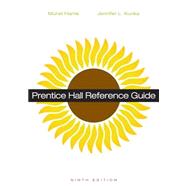For first year composition courses.
Prentice Hall Reference Guide , Ninth Edition, is a tabbed, spiral-bound handbook is written to help all writers, including students who may not know proper terminology, quickly find the information they need.
Teaching and Learning Experience
This text will provide a better teaching and learning experience–for you and your students. It provides:
· A series of “portals” in Tab 1, through which students can quickly find the answers to their writing, research, and grammar-related questions: Helps students at all levels of learning locate the help they need.
· Tried and true advice at every stage of the writing process from instructors who have over 30 years of combined experience working with students: The text is written to students and speaks to them using language they can understand.
· A compact, four-color design with spiral binding and tabs: Makes the book easy to use.
0321993071 / 9780321993076 Prentice Hall Reference Guide with NEW MyWritingLab with eText -- Access Card Package
Package consists of:
0205870147 / 9780205870141 NEW MyWritingLab with Pearson eText -- Valuepack Access Card
0321921313 / 9780321921314 Prentice Hall Reference Guide








